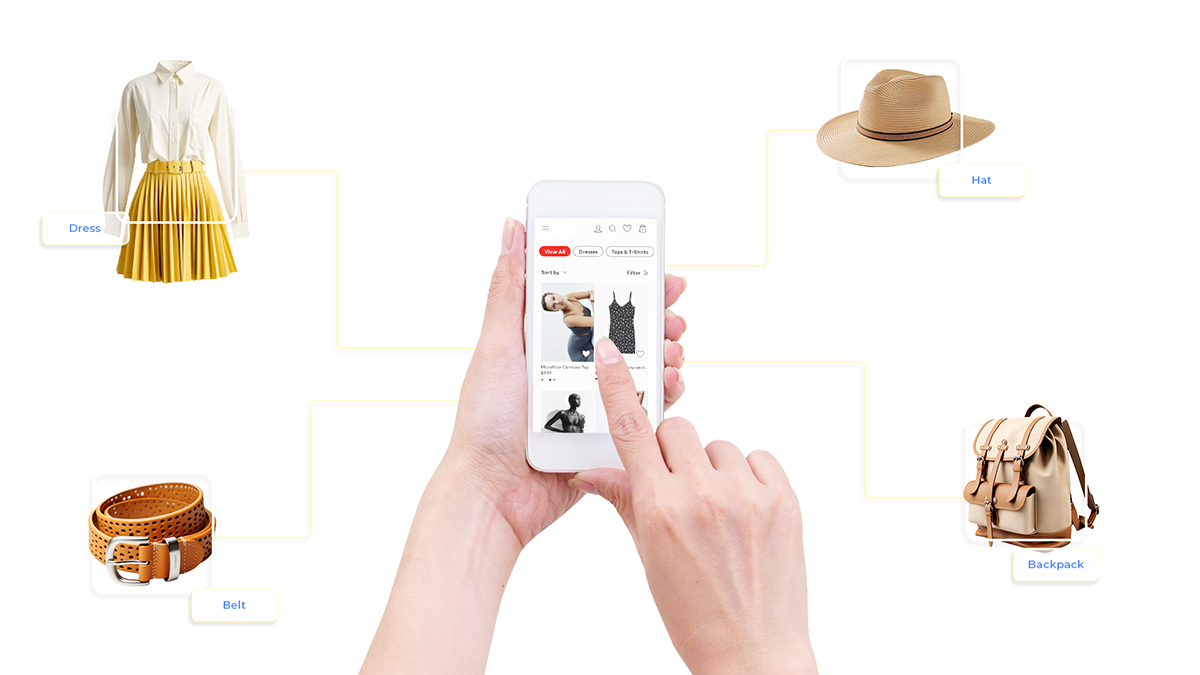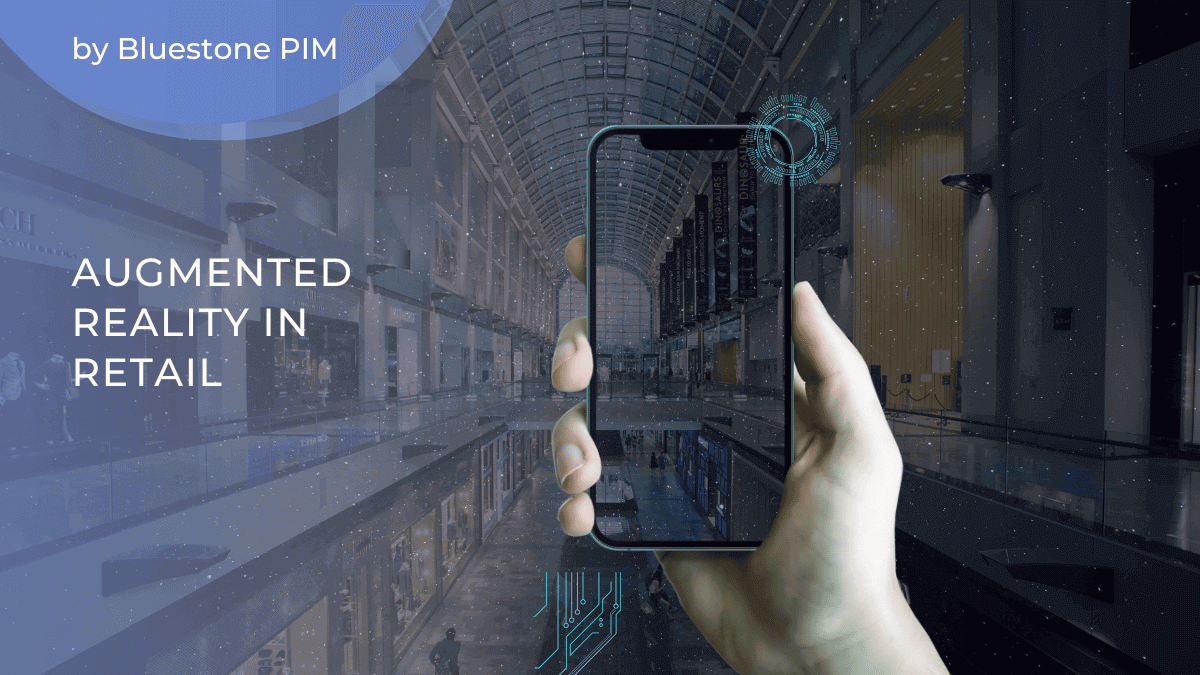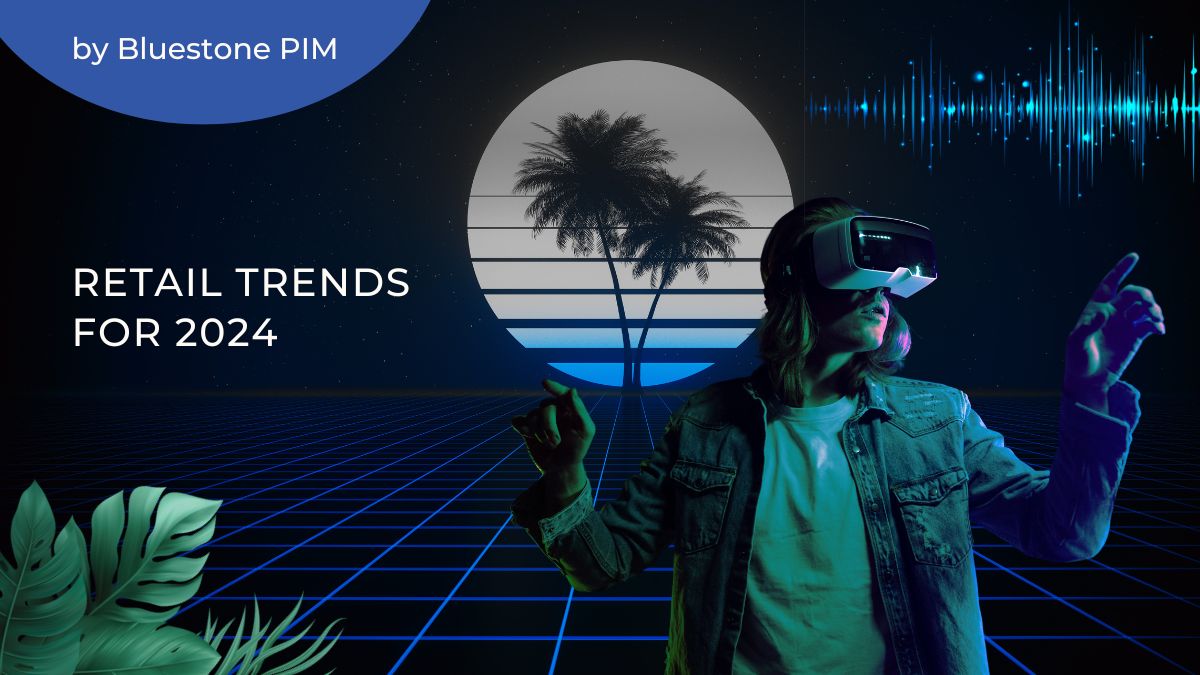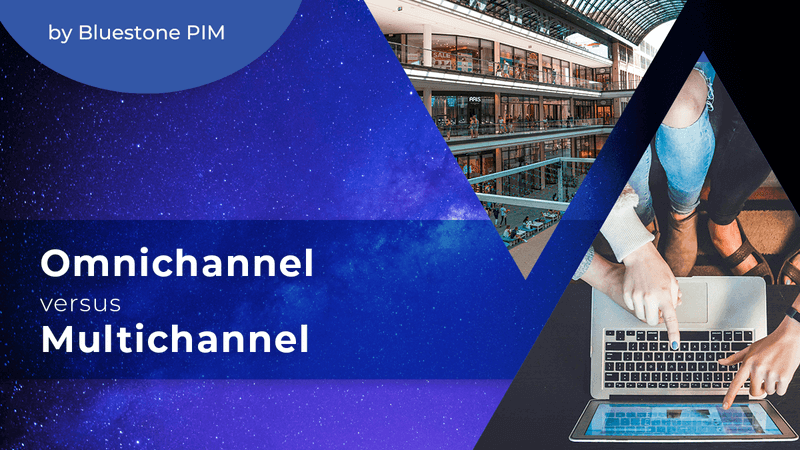Phygital Experience: How to Engage Customers in a Whole New Way

The Jetsons got one thing undeniably right: the future of shopping is intertwined with the glow of a screen. While their "televiewer" might look quaint compared to today's smartphones, they foresaw the future of being eCommerce, accessible from anywhere, on any device. While the Jetsons underestimated the speed of technological advancement, they clearly sparked our imagination.
Today, we've surpassed this vision in many ways, especially in retail. What’s ahead is a seamless blend of online and physical stores ("clicks and mortar"), which we call ‘phygital’. While online shopping is not slowing down (it’s expected to account for 24% of global retail sales by 2026), physical stores were not abandoned by customers but rather embraced in their buying journey.
So, how does phygital experience work?
Imagine stepping into a clothing store and being able to try on a pair of virtual shoes on a holographic mirror. This isn't science fiction, but a new level of shopping experience. It allows customers to enjoy the convenience of online shopping with the tangible benefits of physical stores, like trying on clothes or browsing products in person.
The idea is to seamlessly blend both worlds to create a connected, omnichannel shopping journey. If you analyse the shopping behaviour of generations, it does make sense for retailers to blend both worlds, as there are some significant differences in how younger and older consumers interact with products. While analysts predicted shopping in-store to be dead, a staggering 42% of US Gen Z clothing buyers say browsing in-store is their top discovery channel and surprisingly slightly more important than brand websites or apps (39.8%). This proves that with all the technological advancement, younger consumers still value the real-life experience.
On the other hand, boomers have an even greater preference for in-store shopping. Just by observing these different generational behaviours, we can understand what challenges are faced by retailers trying to cater to such a wide range of shopping behaviours and ensure that both online and offline experiences satisfy their needs.
Considering the above, this phenomenon deserves a better understanding and analysis of future implications for retailers, weighing the pros and cons and challenges behind closed doors. We will try to show you how to build a seamless customer experience that keeps both the customers and your revenue in good shape for years to come.

Why Phygital Experience Matters
Phygital retail blends the convenience of online shopping with in-person interaction to create a transition between both worlds, so shoppers can effortlessly move between browsing products online, checking inventory in-store, and finally purchasing wherever is most convenient for them.
This presents a rather complex buying journey, with variable steps along the way. If one of these experiences comes with obstacles (think: an in-app bug or unsatisfactory customer support experience), it can put the consumer off the purchase completely (with 32% of buyers willing to leave the brand after one bad experience). Phygital approach is the response to transcending the traditional brick-and-mortar versus online debate, filling the gaps and creating more opportunities for improved customer experience and, as a result, increased loyalty (sounds like a bold statement, but we will explore in detail how as we move on).
According to Rick Parrish, VP and Research Director at Forrester, "US consumers are having the worst experiences in a decade." This statement highlights the critical need for brands to prioritise customer experience (CX). While businesses recognise the importance of putting customers first, many struggle with the scale of transformation required. However, the rewards are undeniable: Forrester's research proves that customer-centric companies outperform competitors in terms of revenue, profit, and loyalty.
This leads to the conclusion that brands aspiring to stay relevant can no longer afford to be siloed. That’s because consumers expect a consistent experience across all touch points, whether they're browsing online or looking at a specific product in-store, and expect to see the same stock available in selected sizes.
It presents a lot of challenges for inventory management, yet by leveraging cutting-edge technologies like augmented reality (AR) and virtual reality (VR), brands can create a more engaging and interactive customer journey. The benefits extend beyond just the shopping experience. Phygital initiatives, such as click-and-collect options and QR codes for product details, provide valuable data on customer behaviour and preferences. This real-time feedback allows businesses to refine their product offerings and marketing strategies.
It’s no longer just about the price, according to the National Retail Federation (NRF). Research indicates that although price and quality remain paramount for consumers, convenience presents a significant barrier to purchase completion. Notably, 97% of consumers have abandoned purchases due to inconvenience (NRF). Phygital retail provides an opportunity to create a truly differentiated customer experience, one that is both personalised and memorable.
It offers several benefits around the key focus areas:

#1. Customer Engagement Through VR Technology
Phygital experiences are inherently more engaging due to their ability to enhance interaction with powerful technology, promote interactive experiences and, as a result, capture customers’ attention (these days, it's a lot harder than you might think).
A great example of this is how, a few years ago, a Swedish furniture giant, IKEA, enabled customers to utilise virtual reality (VR) to visualise furniture arrangements within their own homes using augmented reality and more recent innovations. IKEA is making headlines with a unique job opportunity in the Metaverse. The furniture giant recently announced plans for "The Co-Worker Game," a virtual IKEA store within the popular gaming platform Roblox. Here's the twist: IKEA is looking for real people to play the role of in-game employees!
These "virtual employees" will take on tasks familiar to any Ikea shopper: serving up those iconic Swedish meatballs, assisting players in finding virtual furniture and other Ikea products, and even progressing through the ranks—just like in a real IKEA store.
#2: No Room for Friction in The Buying Journey
Phygital retail removes friction from the shopping experience. Imagine finding a product online, then easily picking it up in-store or having it delivered right to your door (click and collect). This convenience keeps customers coming back for more.
Since the pandemic, click-and-collect has been embraced worldwide, with some of the largest UK-based retailers taking it to the next level. For instance, clothing retailer John Lewis is partnering up with another brand and going beyond the traditional model. It leverages the strengths of each brand's physical presence and co-op's extensive network in larger towns provides convenient pick-up points for customers, while John Lewis maintains a physical presence closer to local communities.
Another recent example of blending physical shopping with digital solutions is Zara, a Spanish fashion giant that is using AI-powered robots to speed up online order pickup. The reason for this development is that customers were enabled to order online and pick up in-store, but long queues turned them away from fully adopting this service. Zara's robots can grab roughly 2,400 packages at once, allowing customers to quickly get their purchases with a PIN code assigned. This is yet another great example of how robotics is transforming the retail industry.
#3: Nurturing Customer Loyalty Through Omnichannel Consistency
These days, customer loyalty is a priceless commodity and something retailers have to increasingly fight for. With the generational shift, gone are the days of an immensely loyal Boomer generation. Research indicates that only 30% of Gen Z shoppers would revert back to their go-to brand for another product or service.

Imagine browsing a sporting goods website and saving specific items to a wishlist. Upon entering the physical store, a sales associate equipped with a tablet can access your online preferences. No more searching—brands can offer personalised recommendations based on your saved items, streamlining your shopping journey.
This level of service, enabled by a unified online and in-store presence, makes customers feel valued and understood. It strengthens the brand connection, transforming a simple purchase into a positive and memorable experience.
The possibilities of phygital retail extend far beyond the sporting goods example. Beauty stores can leverage tablets to offer personalised makeup consultations, analysing skin type and recommending suitable products based on a customer's online browsing history. Another great example from the beauty industry is the French conglomerate L'Oréal Paris, with one of their brands, L'Oréal Professionnel, making waves in the metaverse, becoming the first hair brand to launch virtual styles across multiple platforms (Ready Player Me, Roblox, Zepeto). Their latest collection offers Metaverse users new ways to express themselves virtually.
grocery industry has not been left behind either, implementing in-store digital signage that showcases recipes alongside highlighted ingredients, allowing customers to seamlessly add recipe ingredients to their online carts while shopping.
How to Get Started With Phygital
Adding random features to your mobile app or copying competitors won’t get you anywhere. The real power is behind identifying key pain points on the traditional customer journey and coming up with digital solutions to fix them. It’s the technology that comes in with a variant of choice, convenience or more engaging experience to bridge the gap between physical store and online shopping.
Here are some key considerations to begin your journey with implementing phygital experience into your customer experience:
Create a Consistent Omnichannel Strategy
Having a consistent omnichannel strategy equates to a consistent brand experience across all touch points, from the sleek design of your website to the personalised service offered by in-store staff. Customers should feel like they're interacting with the same brand, regardless of whether they're browsing a social media post, researching products online, or visiting a physical store.
Embrace Your Customer at the Centre of Your Strategy
The key to a successful phygital strategy lies in a customer-centric approach. This means going beyond simply adding digital elements to your physical store. It requires understanding your customers' pain points and aspirations across all touch points.
“Having the ability to build and ship relevant digital customer-centric experiences quickly to the market will definitely be pivotal to the success of online retail. Companies and brands are creating different touch points to interact with customers and collecting precious data needed to build even better campaigns and experiences, so connecting this CX data will be of high significance.”
Jimmy Ekbäck | CTO, Occtoo
Invest in Tech
Technology plays a pivotal role in bridging the online and offline worlds. For example, a product information management (PIM) system is an essential tool that retailers can use to conveniently manage product details across all channels. This ensures consistency and eliminates customer frustration caused by conflicting information. Imagine a customer saving a specific pair of shoes online, only to discover in-store that the size or colour description doesn't match. PIM systems prevent such glitches, ensuring a smooth shopping experience.
Another example of a crucial piece of digital software to fully enable phygital experience is payments. Customers expect their preferred payment options to be readily available, whether they're browsing online or shopping in-store.
Omnichannel payment platforms are the key. These platforms not only provide a consistent checkout experience but also capture valuable data on customer payment habits. This data empowers businesses to personalise experiences, optimise marketing strategies, and ultimately drive sales. The bottom line? Frictionless payments are one of the main drivers in the retail industry and are the cornerstone of successful phygital commerce.
Invest in People to Become Your Phygital Ambassadors
While technology is a powerful enabler, it's equally important to empower your teams. We often see these retail brands bragging about new technology being released, yet when you visit the store, no one is there to show you how things work or share any new digital product launches. It’s extremely important for the employees to be trained on how to leverage phygital technologies to their full potential. This may involve using tablets in-store to help customers with product comparisons and personalised recommendations or utilising interactive displays to showcase product features and functionalities.
I am a strong believer that a skilled (and passionate) staff that seamlessly blends digital tools with traditional customer service is essential for creating a truly engaging phygital experience.
Key Benefits of Phygital Experience to Customers
Phygital retail shatters the limitations of traditional shopping, creating an experience that's both interactive and effortlessly convenient by:
Fully Engaging the Customer
Undoubtedly letting customers try, test and feel the product in-store on so many different levels provides the true essence of what you’re buying. It's an engagement that online shopping simply can't match. But phygital seamlessly blends this sensory experience with the efficiency of digital technology. Long checkout lines become a relic of the past, replaced by a smooth and speedy transaction.
Offering Meaningful Connection
Phygital retail isn't just about buying; it's about a deeper connection with the brands you love. Through the power of data, stores can anticipate desires, offering personalised recommendations and exclusive deals tailored to your unique style. It's like having a shopping companion who knows you better than you know yourself.
Putting the Customer in the Driver’s Seat
The frustration of that perfect item being out of stock? Phygital gives you real-time control. With a quick scan or tap, you can see if your desired item is waiting for you in-store or ready for immediate delivery. No more wasted trips; customers are empowered to make informed decisions and snag exactly what and when they want.
Business Value of hygital for retailers
Phygital is an innovative strategy that creates more engaging and personalised customer experiences (CX). It offers several compelling advantages for businesses too, improving connection while simultaneously empowering data-driven decisions.
Online shopping provides retailers with a huge competitive advantage by discovering customer preferences and touch points. By analysing this data, businesses gain a deeper understanding of their target audience, enabling them to identify trends, anticipate customer needs, and make informed decisions. As a result, retailers make decisions that impact their bottom line, for example, optimising inventory management or marketing campaigns, both of which lead to improved operational efficiency and increased profits.
In conclusion, phygital presents a compelling proposition for businesses as well as customers. By embracing this strategic approach, businesses can position themselves for continued growth rather than missing out on understanding customer needs and risking being left behind.

Final Thoughts
Whether you're a major retailer or a small business owner, phygital retail offers a powerful way to drive sales. By leveraging this approach, you can create a shopping experience that's both convenient and engaging.
Needless to say, the retail of the future is no longer defined by a binary choice between online and offline experiences. Phygital represents real customer engagement. By leveraging digital solutions, businesses can create a seamless journey that is definitely more empowering and, if executed correctly, fixes a lot of missing opportunities.
The first step lies in understanding your customers' needs and preferences across all channels. Secondly, ensuring consistent product (or service) information in one place to create an omnichannel strategy and providing frictionless payment options.
We’ve been working with global retailers across the globe to optimising product data to enable omnichannel and personalised experiences. If you want to explore how you can master phygital with the right data, schedule a free consultation with our PIM experts and discover how we can help make your customers even more excited about interacting with your brand.T




